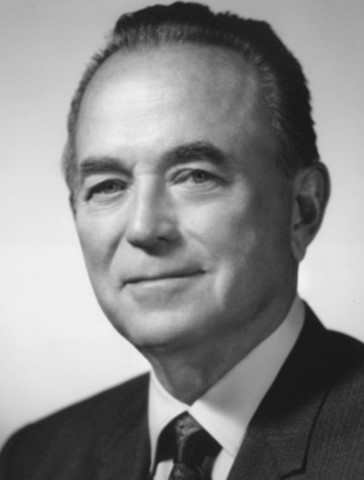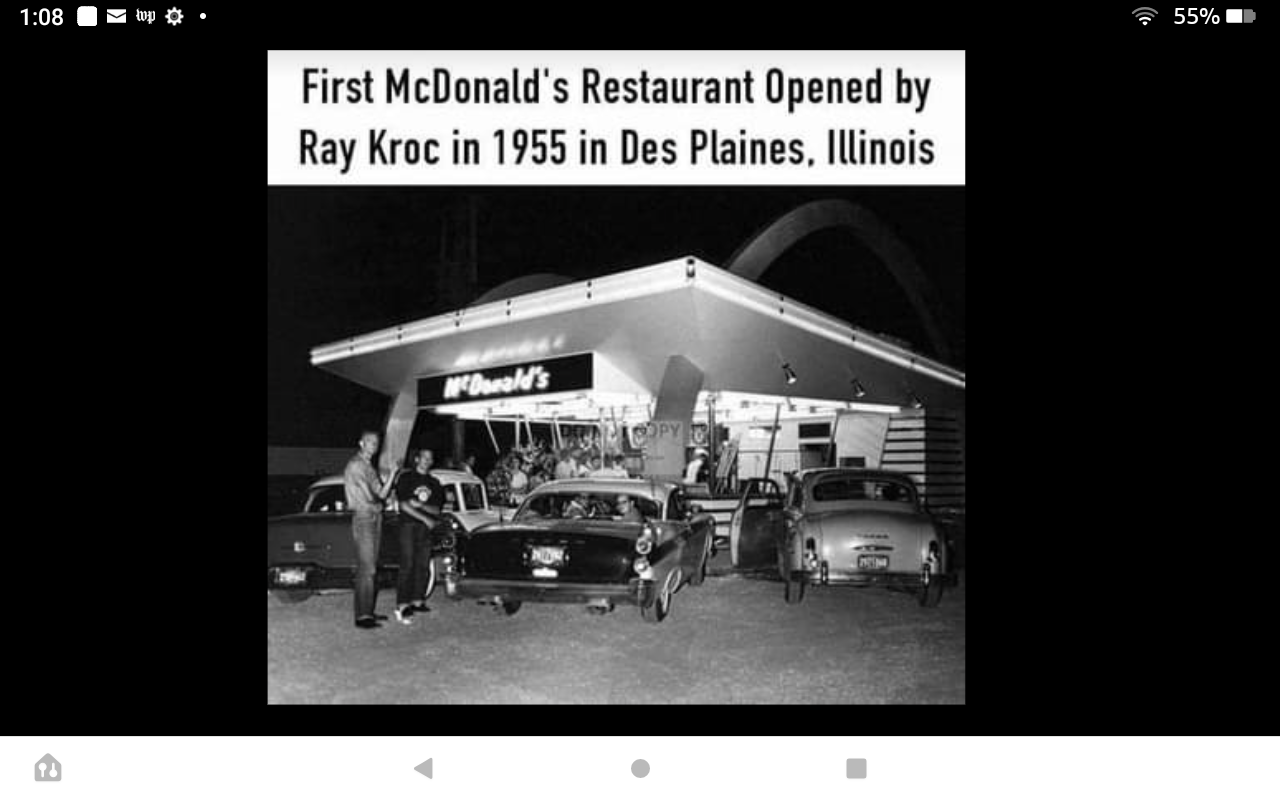Ray Kroc -- Mcdonald's

Click for PDF version of Ray Kroc -- Mcdonald's -- Biography
Introduction
 Picture of Ray Kroc -- Mcdonald's
Picture of Ray Kroc -- Mcdonald's
 Picture of Ray Kroc Life Stats
Picture of Ray Kroc Life Stats
Raymond Albert Kroc (October 5, 1902 – January 14, 1984) Wikipedia page
October 25, 2014
RAY KROC
Foundor
McDONALD’S
by
Richard E. Hattwick
Ray Kroc was born in the Chicago suburb of Oak Park in 1902. He dropped out of high school because he was too anxious to start earning money. Brimming with confidence, Kroc began his career with two jobs. By day he would sell ribbon novelties, door-to-door. By night he would play the piano for various groups on a one night stand basis. Within a few years he had graduated to selling paper cups to restaurants and playing the piano six days a week for a local radio station. He was only able to work in five hours of sleep at night, but as he put it, “I was determined to live well and have nice things, and we could do so with income from my two jobs.”
Ray Kroc eventually decided to give up piano playing and devote himself full time to selling paper cups. He was an outstanding salesman and soon had 15 salesmen working under him.
At the age of 35 Ray Kroc decided to strike out on his own. He borrowed heavily to raise the money to start a company selling a multiple spindle milkshake mixer. His wife was worried about the risk he was taking, and argued against the move, but Kroc told her, “You have to take risks, and in some cases you must go for broke.”
For more than a decade, Ray Kroc made a living marketing his mixers. He set up a tiny office run by a secretary while he traveled all over the country visiting potential customers and operating sales booths at restaurant and dairy association conventions. He made good money, but operation was small. It was not until 1948 that he was able to hire a bookkeeper. In a good year he would sell 5,000 mixers.
By 1950 Ray Kroc was convinced that the mixer business had peaked and he began a serious search for a new product to sell. He heard stories of the amazing volume of business being done by two Californians at their San Bernardino, California, drive-in restaurant. His curiosity was further aroused when the McDonald brothers ordered a large number of mixers from him. And so in 1954 Ray Kroc went to San Bernardino, California, to find out what the McDonald brothers were doing with their drive-in restaurant.
What Ray Kroc found in San Bernardino was the model for the fast food revolution. The McDonald brothers sold a limited menu of hamburgers, french fries, and drinks. They had standardized the production process in a way which cut costs and maintained a high level of quality. By selling a high volume of food every day they could make a good profit at an unbelievably low price for the food being sold. Hamburgers, for example, sold for 15 cents even though “everyone knew” that you couldn’t make a profit at less than 25 cents per hamburger.
Kroc recognized the potential national market for this approach. He signed a contract with the McDonald brothers which allowed him to own and franchise similar restaurants across the country. Kroc would charge each franchise $950 plus 1.9 percent of gross sales. The McDonald brothers would receive 0.5 percent out of Kroc’s 1.9 percent.
Kroc returned to Illinois where he prepared to pen a demonstration store. There were numerous complications involved, but Kroc overcame them all and opened his Des Plaines, Illinois store on April 15, 1955. Help was hired to run the store during the day, while Kroc continued to work at his mixer company. But after work Kroc plunged into the task of expanding his McDonalds’ chain.
In May of 1955 Kroc was visited by Harry Sonneborn, who had just resigned as a vice president of the Tastee Freeze company. Sonneborn had observed the new McDonald’s restaurant and concluded that the concept was a winner. He told Kroc that he would like to get involved. Ray Kroc did not believe that he could afford another employee, but he also felt that he needed the skills which Sonneborn had to offer. And so Kroc asked Sonneborn to figure out the lowest possible salary he could live on and Kroc would then decide whether or not he could afford Sonneborn. Sonneborn came back with a figure of $100 a week take home pay. Kroc hired him at that salary. It was one of the wisest moves ever made by Ray Kroc, for Sonneborn’s financial innovations were to become crucial for the rapid growth of McDonald’s.
Ray Kroc’s concept of his business was that of a family oriented restaurant giving quick service. The limited menu of standard quality items would be offered at a low price. The food would be served in pleasant surroundings exuding cleanliness. In Kroc’s view, it was essential to maintain quality standards throughout the chain. To do so, thought Ray Kroc, it would be desirable to build the restaurants and then lease them to the franchisees. This policy, along with the terms of the franchise agreement, would enable McDonald’s to maintain the desired quality standards.
However, in order to build the restaurants, Kroc needed capital. And here is where Sonneborn’s skills came into play. Harry Sonneborn devised an arrangement whereby a local land owner would lease his land to McDonald’s, taking a second mortgage. Kroc and Sonneborn would then go to a bank and get a first mortgage loan on the building. It was a technique which worked because in those days, the land owners did not have any other groups willing to lease the land. Later, of course, competition for the fast food sties would make the arrangement impossible to implement.
Sonneborn also developed a formula whereby the franchisee made monthly payments covering the mortgage payments plus a profit for McDonald’s. This became such a lucrative source of revenue that some observes called McDonald’s a real estate business with a fast food business sideline.
 Picture of first Mcdonalds
Picture of first Mcdonalds
In 1956 McDonald’s opened 11 franchised stores. Twenty-five more were opened in 1957. By that year, the growth of the chain made it necessary to hire a full time operations man. Young Fred Turner was given the job. Turner began to develop a check list for inspection of operating units, thus further upgrading the quality control effort.
Ray Kroc himself made a total commitment of his time and resources to the goal of dominating the fast food industry. By 1960 his strategy and its effective execution had created a chain of 228 stores with sales in excess of $56 million. But Kroc was not satisfied with the company’ rate of growth. He and Sonneborn decided to build and operate a group of company stores in order to accelerate the cash flow received by the company. To finance this move, Sonneborn arranged a large loan from several insurance companies. He viewed this as the first step in a long run process leading to company ownership of all stores. But Kroc was convinced that the vitality of his organization came in part from the efforts of the franchisees. To Kroc this meant that no more than 30 percent of the stores should be company owned. Kroc’s views prevailed.
By the beginning of 1965 the McDonald’s chain had grown to 657 stores grossing $129 million. McDonald’s was providing training for new operators at its Hamburger University; a research facility was producing a stream of new products; and a program of “field consultations” developed by Fred Turner was proving effective in motivating local store operators to maintain quality standards.
In 1965 two major new developments strengthened McDonald’s competitive position. First, the company went public. The stock was offered to the public at $22.50 per share. Within a month the price had climbed to $50.00 per share. Second, Kroc created a decentralized management structure by establishing a network of regional offices and delegating numerous powers to those offices. This was a move similar to the action of General Robert wood when he adopted a decentralized retail organization structure at Sears, Roebuck in the 1930’s. And just as Sears’ subsequent success was credited in part to the decentralized structure, so both Kroc and a number of his licensees cite the regional offices as a key to the subsequent profit growth at McDonald’s. The role of the regional offices in providing supporting services and maintaining tight quality controls at the local stores cannot be overemphasized.
There was another development in 1965 that signaled the form which future competition was to take. In 1965 McDonald’s made its first addition to the menu – a fish sandwich. In 1966 a more frivolous, yet probably more significant competitive tool was introduced by McDonald’s. The company unveiled Ronald McDonald, a clown who symbolized the McDonald’s strategy of appealing to the children of the middle class family. In advertising and in live appearances at local stores, actors dressed as Ronald McDonald helped build traffic for McDonald’s. The following year one of the most significant competitive weapons was unveiled when McDonald’s launched its first national advertising campaign and markedly raised the cost of competing. Kroc had always been a strong believer in the value of advertising, but prior to 1967 McDonald’s had focused its advertising efforts on the local level. Once into national advertising, McDonald’s quickly became one of the country’s leading advertisers. The advertising program was funded by a “voluntary” contribution of 1 percent of gross sales of each store.
McDonald’s was entering the period of its greatest growth. Yet it was at this time that Harry Sonneborn chose to leave the company. His decision was influenced by disagreements between himself and Ray Kroc over the way the company should be run. And at the time he left, he was so certain that the company was heading for trouble, that he sold the substantial bloc of McDonald’s stock which he owned. The sale netted him several million dollars. But had he kept faith and held on to the stock, he would have been able to sell it a decade later for over $100 million.
A year after Sonneborn’s departure, Kroc elevated Fred Turner to the presidency of the company and what might be termed the “post Ray Kroc era” at McDonald’s began.
Led by Turner, McDonald’s continued to excel. The quality controls, basic strategy and commitment to advertising remained the same. But he advertising campaign themes changed with the times. The appearance of the stores changed and indoor seating was added. New items were included on the menu, beginning with a large double burger called the “Big Mac” which was introduced in 1968. Perhaps the most significant menu addition was the package breakfast items offered on a nationwide basis in 1976. Within a year, breakfast sales were accounting for approximately 10 percent of McDonald’s sales.
The Turner years also saw McDonald’s expand into new geographical areas. Stores were opened in foreign countries, in the central cities of the United States, and in the new enclosed shopping malls which began to blanket the country.
Ray Kroc continued to take an active interest in the company in the 1970’s, serving as chairman of the board. But he also began to devote a great deal of his time to charitable activities and the San Diego professional baseball club which he purchased in 1974.
This article was written by Dr. Richard Hattwick.
Copyright © 2001 American National Business Hall of Fame. All Rights Reserved.
Copyright 2001 American National Business Hall of Fame. All Rights Reserved.



